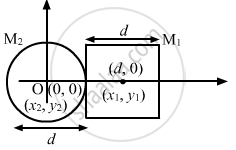Advertisements
Advertisements
प्रश्न
A square plate of edge d and a circular disc of diameter d are placed touching each other at the midpoint of an edge of the plate as shown in figure. Locate the centre of mass of the combination, assuming same mass per unit area for the two plates.
उत्तर
Let m be the mass per unit area of the square plate and the circular disc .

\[\Rightarrow\] Mass of the square plate, M1 = d2m
Mass of the circular disc, M2 = \[\frac{\pi d^2}{4}m\]
Let the centre of the circular disc be the origin of the system.
\[\Rightarrow\] x1 = d, y1 = 0
x2 = 0, y2 = 0
\[\Rightarrow\] Position of the centre of mass of circular disc and square plate:
\[= \left( \frac{m_1 x_1 + m_2 x_2}{m_1 + m_2}, \frac{m_1 y_1 + m_2 y_2}{m_1 + m_2} \right)\]
\[ = \left( \frac{d^2 md + \pi\left( d^2 /4 \right) m \times 0}{d^2 m + \pi \left( d^2 /4 \right) m}, \frac{0 + 0}{m_1 + m_2} \right)\]
\[ = \left( \frac{d^3 m}{d^2 m(1 + \pi/4)}, 0 \right)\]
\[ = \left( \frac{4d}{\pi + 4}, 0 \right)\]
Hence, the new centre of mass of the system (circular disc plus square plate) lies at distance \[\frac{4d}{(\pi + 4)}\] from the centre of circular disc, towards right.
APPEARS IN
संबंधित प्रश्न
A child sits stationary at one end of a long trolley moving uniformly with a speed V on a smooth horizontal floor. If the child gets up and runs about on the trolley in any manner, what is the speed of the CM of the (trolley + child) system?
If all the particle of a system lie in a cube, is it necessary that the centre of mass be in the cube?
A collision experiment is done on a horizontal table kept in an elevator. Do you expect a change in the result if the elevator is accelerated up or down because of the noninertial character of the frame?
In an elastic collision
If the external force acting on a system have zero resultant, the centre of mass
(a) must not move
(b) must not accelerate
(c) may move
(d) may accelerate.
Seven homogeneous bricks, each of length L, are arranged as shown in figure. Each brick is displaced with respect to the one in contact by L/10. Find the x-coordinate fo the centre of mass relative to the origin shown.
Calculate the velocity of the centre of mass of the system of particles shown in figure.

A ball of mass m is dropped onto a floor from a certain height. The collision is perfectly elastic and the ball rebounds to the same height and again falls. Find the average force exerted by the ball on the floor during a long time interval.
Consider the situation of the previous problem. Suppose each of the blocks is pulled by a constant force F instead of any impulse. Find the maximum elongation that the spring will suffer and the distance moved by the two blocks in the process.
Consider the situation of the previous problem. Suppose the block of mass m1 is pulled by a constant force F1 and the other block is pulled by a constant force F2. Find the maximum elongation that the spring will suffer.
Consider a gravity-free hall in which an experimenter of mass 50 kg is resting on a 5 kg pillow, 8 ft above the floor of the hall. He pushes the pillow down so that it starts falling at a speed of 8 ft/s. The pillow makes a perfectly elastic collision with the floor, rebounds and reaches the experimenter's head. Find the time elapsed in the process.
Two balls having masses m and 2m are fastened to two light strings of same length l (See figure). The other ends of the strings are fixed at O. The strings are kept in the same horizontal line and the system is released from rest. The collision between the balls is elastic. (a) Find the velocity of the balls just after their collision. (b) How high will the ball rise after the collision?

Define centre of mass.
In system of two particles of masses 'm1' and 'm2', the first particle is moved by a distance 'd' towards the centre of mass. To keep the centre of mass unchanged, the second particle will have to be moved by a distance ______.
The centre of mass of a system of two particles divides the distance between them ______.
The centre of mass of a right circular cone of height h, radius R and constant density `sigma` is at ____________.
Which of the following statements are correct?
The spheres of masses 2 kg and 4 kg are situated at the opposite ends of wooden bars of length 9 m. Where does the centre of mass of the system will ______.
